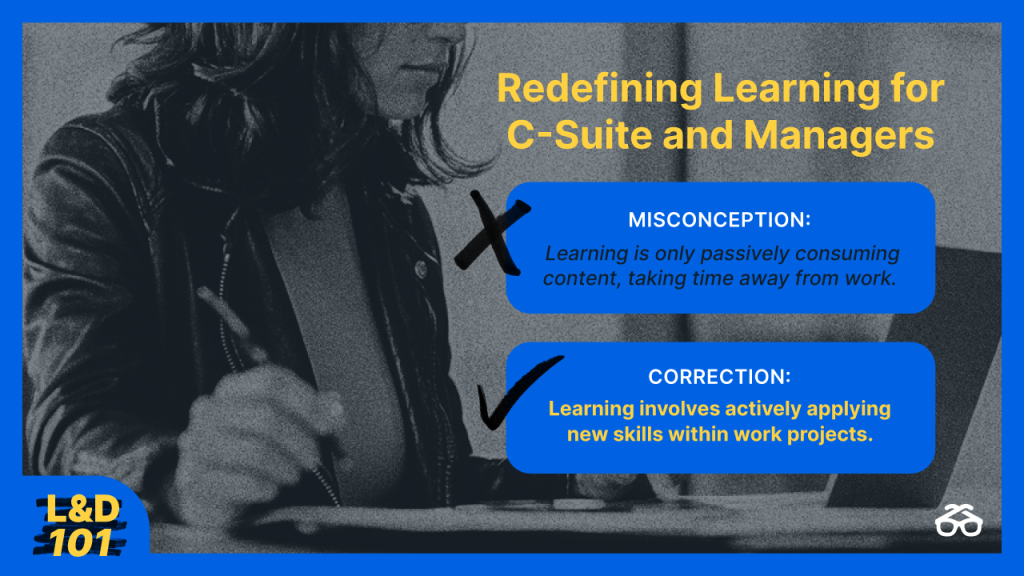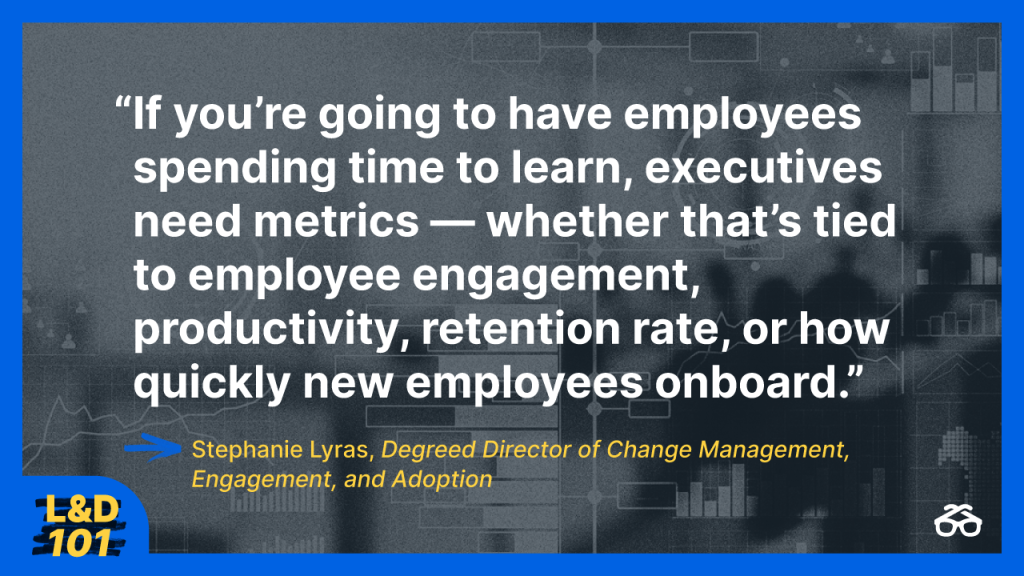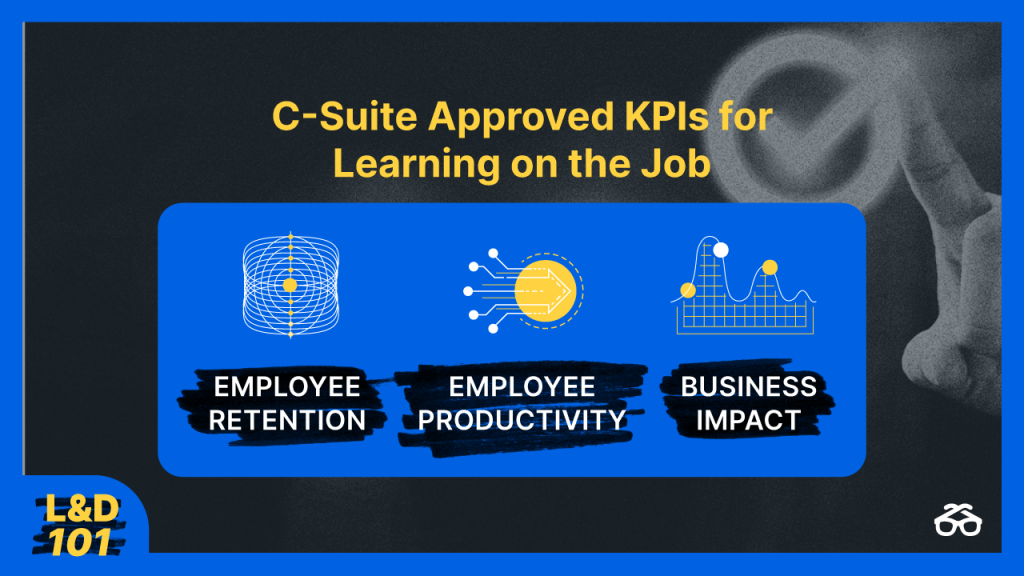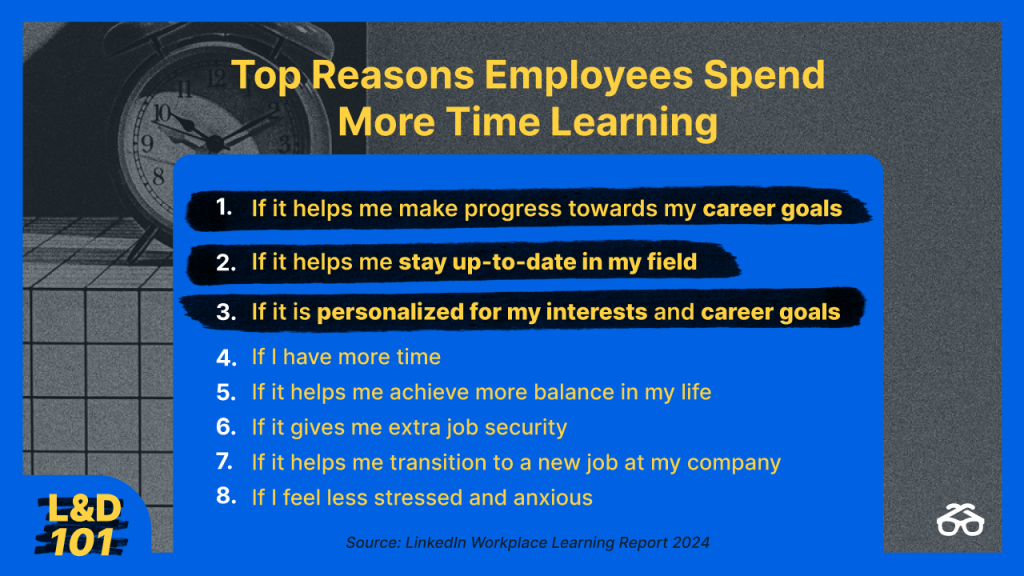The skills race is on, yet the #1 challenge facing L&D professionals is providing employees enough time to learn at work. Employees sit on the starting line long after the starting gun is fired because they don’t have time to learn new skills.
How can L&D professionals give employees enough time to learn at work?
Everyone wants to win. To achieve success, you must demonstrate to executives, employees, and managers that investing more time to learn at work is crucial. They all want to know how learning helps them complete their leg of the race, and that answer is different for all three. Executives need business alignment, employees need growth and managers need clear strategies to develop team members.
Getting buy-in at all levels can feel as daunting as running a marathon. But if you first reframe how people typically think of time to learn at work, it’ll be an easier sell all around.

Reframing Time to Learn at Work
How do we carve out more learning time without slowing the pace toward company goals? That is the question L&D professionals get on repeat from executives, managers, and employees. However, the question is problematic because it assumes that learning at work always deters productivity.
Currently, business leaders and managers often think of learning hours as time dedicated to formal training. But if C-suite and managers (and even employees) only think of learning time as separate from work, they miss out on other critical forms of learning.
If companies also invest in other kinds of learning like experiential learning and learning in the flow of work, you’ll boost learning without pulling employees away from productivity. And that makes getting buy-in from everyone easier.
Experiential Learning
When a runner completes a 5k while training for a marathon, they get real-world race experience and earn a medal. Similarly, L&D programs that include experiential learning give employees contextualized learning while producing deliverables for the business. Experiential learning might include:
- Special projects
- Shadowing assignments
- Internal apprenticeships
- Trial periods
“Learning doesn’t always mean that you’re consuming content and taking a full time-out from work hours,” notes Stephanie Lyras, Director of Change Management, Engagement and Adoption at Degreed. The team of experts she belongs to helps organizations align learning to business strategy and measure learning impact. “When we see and can prove learning is an integrated part of delivering business outcomes, we can shift mindsets at the executive level to truly understand the value of learning.”
Learning in the Flow of Work
If experiential learning is like finishing a 5k, learning in the flow of work is like setting up cups of Gatorade along the route. Employees can get the juice they need to keep speeding along on their current tasks. Many employees learn in the flow of work as they run into and resolve on-the-job challenges by themselves, but L&D can invest in these moments to foster learning while boosting productivity.
Learning in the flow of work can look like:
- Googling a tutorial: Many employees do this on their own without L&D intervention.
- Asking a colleague: Foster these conversations by developing a mentoring and coaching program.
- Microlearning at the point of need: Bite-size content that employees can find in seconds and devour in minutes.
- Nudges: Brief reminders (usually push notifications or emails) about how to use knowledge on the job.

Buy-in from Executives
While it’s an important step to reframe learning time in terms of work productivity, for executives, the value of employees having more time to learn at work also comes from driving meaningful business outcomes. If you can walk the C-suite through a clear connection between learning on the job and business objectives, it’s much easier to get them onboard.
Many L&D pros struggle with speaking C-suite, but they also know that aligning learning programs to business goals is critical. It’s their #1 L&D focus area in 2024, according to LinkedIn’s Workplace Learning Report. But you’ll also need a plan for tracking your program’s success.
“If you’re going to have employees spending time to learn, executives need metrics,” says Lyras. “Whether that’s tied to employee engagement, productivity, retention rate, or how quickly a new employee onboards. You need a solid measurement strategy to track regularly so you can respond to the insights.”

The KPIs of Learning on the Job
Employee Retention
According to LinkedIn’s 2024 Workplace Learning Report, companies that prioritize learning see a 27% boost in employee retention. Those with a strong commitment see a 57% boost.
If learning increases retention by half, then it saves your company money. It saves you money because it costs six times more to replace someone than train them internally. Get a pulse on current employee retention rates, and start doing the math for the future of retention.
Changes in Employee Productivity
While engagement has been a staple L&D metric for years, the C-suite won’t see a clear connection to their bottom line. So translate engagement into a metric they already know and love: productivity. A Gallup study shows that companies with the highest engagement are 17% more productive—and 21% more profitable—than those with low engagement.
Measuring productivity is unique to each role, and could look different depending on how your company tracks work. If you’ve implemented Objectives and Key Results (OKRs) or Scrum story points, you have built-in productivity metrics. Or you can focus on specific deliverables—like completed projects or finished products. Whatever the metric, consider both the quantity and quality of work.
Business Impacts for Specific Roles
Business impact will vary by department. For customer service, it might be a boost in customer satisfaction or fewer escalations. For sales, there might be more deals closed. Find out which metrics executives want to see, and make sure you’re designing learning experiences that drive them.
Buy-in from Employees
Business outcomes get executives on board, but what gets employees learning? Learning that answers the question: “What’s in it for me?” If employees don’t see the value of learning in your organization — or don’t feel supported — you’ll struggle to get them on board like a couch potato struggles to hit the track.
Showing the value of learning time
The top two reasons employees spend more time learning are to progress toward career goals and stay up-to-date in their field.

Connect Career Paths, Skills, and Learning
Document and share clear career pathing so employees can see exactly what the possibilities are. Then document the skills they need to progress to each level—and the learning activities that will get them there.
Communicate Relevance
Share how you see your company responding to industry advancements like AI and robotics—and how their roles will change as a result. Emphasize the skills employees will need—and that you’re committed to helping them gain them.
Signaling Support
When I train for a race, the support of my friends, family, and trainer keeps me motivated to keep putting in the miles. Similarly, employees need regular reminders that the organization values learning. You can support company learning culture in several ways:
- Nudges: emails and push notifications that remind employees to learn signal that the organization values learning time.
- Microlearning: building easier-to-fit small lessons throughout the day empowers employees to dedicate the time to learn.
- Coaching and mentoring programs: colleagues who dedicate time to an employee’s growth show that coworkers also buy into learning.
- Reflecting and sharing: setting aside time to reflect on training or experiences gives employees the time to solidify their learning.
- Make it part of the conversation: managers who discuss learning in learning in everyday conversations signal leadership buy-in and support.
Buy-in from Managers
Building support at the manager level begins at the C-suite and then trickles down to managers and employees. Executives can praise learning success, hold managers accountable for learning successes, and push for investing in learning technology. And these are all signals to managers that they should climb aboard the learning train.
But you can’t stop at the boardroom. You have to show managers themselves how more learning time will earn them their own medals—AKA, meet their team and department goals and land their bonuses. If you can do that, then you’ve got allies.
Often, your head of people is a great place to start because effective training solves so many HR challenges—like less need to hire talent amid the current skills gap, employee retention and attracting high performers. But you can’t stop at HR, either. You need all managers onboard, and for that you’ll need to switch up your tactics.
Speak Management
When you approach managers about the benefits of providing more learning time, tailor your message. How you do that depends on your company structure, but here’s what managers will want to know:
- Sales: How will more time to learn help employees hit their targets?
- Customer support: How will it boost NPS, customer retention, resolution times, and conversation abandonment rates?
- Marketing: How will it help employees keep up with new trends, channels, and technologies?
- Production: How will it decrease waste, errors, quality issues, and production costs?
The ROI of More Time to Learn at Work
It’s all too easy to get into a stalemate around learning. The old way of thinking pits learning against productivity goals, and it’s the same mindset that views L&D as a cost center, not a value center. But if you reframe learning as complementary to productivity, you’re well on your way to boosting learning time on the job. More importantly, you’re helping your company view L&D as a business-critical initiative—and that’s the key to winning the skills race.
Want to learn more ways to win learning and influence the C-suite? Download, “A Workbook to Secure Stakeholder Buy-In.”

